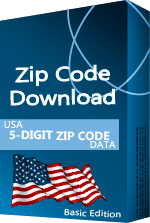Zip Code Database with Latitude & Longitude
ZIP Code Database with Latitude, Longitude and more.

The 5-digit Premium Edition zip code list includes a complete list of US ZIP Codes, the default city for each ZIP Code, alternate cities and spellings, states, the primary ZipCode area code, and individually certified latitude & longitude coordinates.
The ZIP Code files are available in the following formats: Microsoft Excel 97 (or later), Microsoft Access 97 & 2000 (or later), comma-separated values, fixed-width format, and tab-delimited format. All formats are included with your purchase, and they can be imported into most databases and spreadsheets.
Our 5-digit ZIP Code data works great as a ZIP Code directory and is the perfect solution for developers who need raw ZIP Code data. All of our databases come with a 30-day Money Back Guarantee , so try us out today. Find out more...
Product Features & Benefits
- Useful for distance and radius ZIP Code searches
- Lowest Price on the Net
- 30-Day Money Back Guarantee
- Updated Monthly with official USPS data
- Raw text formats compatible with any database, including SQL Server, Oracle, MySQL, DB2, Access, and Postgre SQL
- Award-Winning Customer Service
- Site License - you may install this product on all computers within your organization
- Used by more Fortune 500 Companies - Amazon.com, American Express, AOL Time Warner, Apple Computer, Inc., AT&T, Bank One, FedEx, Ford Motor Co., Kodak, Microsoft Corp., Walmart, Wells Fargo & Company and many more.
Zip Code Data
Have you ever considered just how the government regulates all of that data out there relating to your position within the country? This zip code data is compiled and placed in categories known as ZIP code tabulation Areas (ZCTAs). These areas are based off of the system of ZIP code categories created by the USPS.
These USPS Zip code point out the post offices or any delivery station which is associated with a mailing address. The difference between the two sections is that the USPS version is not an areal perspective , it is a collection for predefined routes which the ZCTAs are indeed areal plans of ZIP code areas.
To create this astounding database of Zip Code Data, the Census bureau decided to study all of the addresses contained within the areas defined by the census distribution. The Zip codes were then listed according to whatever section that they fitted into. These areas were then assigned a preliminary ZCTA code and when all of the areas had been thoroughly catalogues, they were allocated permanent codes depending on where they fitted in on the gird.
The blocks that were assigned buy the bureau were full of addresses, however they did not contain one most frequently occurring ZIP code, in which the blocks set their boundaries.
If there is an area which is particularly remote or to find, the ZCTA is assigned artificially by an extension of a particularly chosen block.
All of this information allows there to be a vast zip code data base compiled which detailed the positions and densities of where people live to an exacting point. This has helped to create a range of extraordinarily useful resources. Tools which allow the viewing and searching of ZIP code databases are now readily available in many formats. These include automated tools online, hard copies taken from Post Offices or CD copies.
These resources can be used to look people up if you only have a limited knowledge of their address in order for you to mail them something. This is important for nationwide logistics as people need to know where they are sending things for the system to work. This successful arrangement is all thanks to the zip code data collection.
Our Products
- US Zip Code Database
- US Zip+4 Database
- Multi County Database
- Canadian Postal Code
- 2010 Census Database
- Zip Code API
- Area Code Database
- NPA NXX Database
- Congressional District Database
- Sales & Use Tax Database
- Health Care Coverage Database
- CBSA Medicare Database
- Statistical Databases
- Mexico Data
- Canada Area Code Database
ZIPCODE DATA SINCE 2002
- USA Product Comparison
- Canada Product Comparison
- Free ZIP Code Finder
- Competitor Evaluation
- Case Studies
- What Can Our Data Do For You?
- Why Is Our Data More Accurate?
- Who Are Our Customers?
- Why Choose Us?
- Zip Code Database
- Postal Code Database
- Free Zip Code Database
- Free Vs Paid Zip Code Database
- Free Zip Code Tools
- Our ZIP Code API
- What is the 5-digit Zip Code?
- USPS Zip Code Database Download
- How to purchase a United States postal service Zip Code Database


